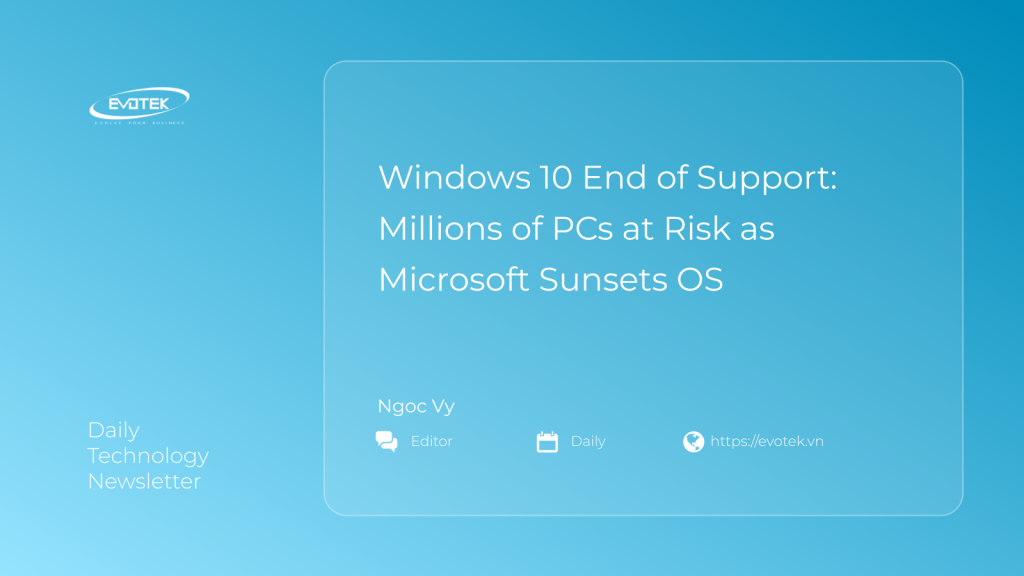In a move sparking widespread concern among consumer and environmental advocates, Microsoft is poised to discontinue free support for its widely used Windows 10 operating system this month. Critics warn this decision, effective October 14th, could render hundreds of millions of computers vulnerable to cyberattacks, generate over a billion pounds of electronic waste, and disproportionately affect users unable to afford costly upgrades.
The impending Windows 10 end of support directly impacts a significant portion of Windows 10 users globally. As the second-most popular OS version, its cessation forces a critical dilemma for owners of devices incompatible with the free Windows 11 upgrade. While businesses can opt for a paid extended support plan starting at $61 per device (a cost that escalates annually for three years), and individuals can secure one year of security upgrades for $30, these options are often prohibitive. For many, the alternatives are stark: invest in a new computer or continue operating an unsupported Windows 10 PC, leaving it dangerously susceptible to hacking.
Alarming Scale of Impact and Calls for Action
Nathan Proctor, senior director of the U.S. Public Interest Research Group (PIRG) Right to Repair campaign, describes the scale of this transition as “alarming.” In stark contrast to the less than 4% of users still on Windows 8 when its support ended in 2016, a significant 42% of global Windows computers currently run Windows 10. This widespread adoption magnifies the potential impact on users worldwide.
Advocacy groups, including PIRG, right-to-repair organizations, and environmental bodies globally, are urging Microsoft to offer free, automatic extended support worldwide. They point to Microsoft’s recent announcement to provide an additional year of support within the European Economic Area as a precedent. Proctor critically questions whether device security is becoming “the privilege of the well-to-do,” highlighting the ethical implications of Microsoft’s strategy.
Economic Strain and the Digital Divide
This accelerated obsolescence of millions of computers comes amidst challenging economic conditions for many working people, including a U.S. unemployment rate at a nearly four-year high of 4.3% and an August inflation rate of 2.9%. For many, upgrading to a new Windows 11 compatible device—which can range from around $300 for a basic laptop to over $3,000 for advanced machines—is simply unaffordable. Even purchasing a used or refurbished computer can present significant costs.
Reliable access to a functional laptop or PC is no longer a luxury but an essential tool for employment, job applications, and the prevalence of remote work. Michael Deeb, director of Civic Tech DC, emphasizes that this isn’t just about internet access but about “equitable access to markets” and the ability to work effectively, underscoring a growing digital divide. This issue also impacts students, as many rely on computers for homework and school-related activities, potentially hindering educational attainment.
Technical Barriers to Windows 11 Upgrade
The technical hurdles for a smooth transition are substantial. Research from 2022 by Lansweeper indicated that approximately 43% of active Windows 10 PCs are technically incapable of upgrading to Windows 11 due to its demanding system requirements. Microsoft’s prerequisites for Windows 11 installation include 64GB of storage, a compatible 64-bit processor, and a 720p HD display. Many older laptops, particularly those manufactured before 2017, simply do not meet these specifications, leaving millions of users in the U.S. (where 36.38% of PC users are on Windows 10) facing device obsolescence and compromised security.
Adding to the challenge, the previously available Affordable Connectivity Program (ACP), a government-sponsored project offering internet subsidies and device allotments, ceased in June 2024, leaving a void in assistance for impoverished households. While non-profit organizations may offer refurbished options and Microsoft has a trade-in program, the supply of affordable alternatives is relatively limited, exacerbating existing digital inequality.
Escalating Cybersecurity Threats
For users who continue with an unsupported Windows 10 OS, the cybersecurity risks are severe. Without ongoing technical maintenance, Microsoft will cease to identify and patch software vulnerabilities, creating open doors for malicious actors. Kevin Cleary, a clinical associate professor at the University at Buffalo School of Management, warns that users often underestimate these invisible dangers. Hackers operate covertly, sometimes for years, to extract valuable personal data for financial gain, with monetary motivation remaining primary.
The Federal Bureau of Investigation’s internet crime complaint center reported U.S. consumer losses exceeding $16 billion in 2024, a 33% increase from the prior year, with phishing, extortion, and personal data breaches being the most common crimes. Individuals over 60 were particularly targeted, suffering $5 billion in losses, highlighting the vulnerability of those facing unexpected costs.
Advocacy for Transparency and Environmental Responsibility
Cybersecurity experts echo consumer advocates in identifying those facing unexpected upgrade costs as the most vulnerable. Florian Schaub, an associate professor at the University of Michigan, stresses that consumers should consider a company’s commitment to long-term software support when purchasing tech products, a transparency effort championed by organizations like Consumer Reports.
A Consumer Reports survey revealed that 72% of smart device owners believe manufacturers should disclose software support lifecycles. In response, Consumer Reports and U.S. PIRG have developed a model bill to mandate such disclosures, arguing it would boost national security. Despite Microsoft’s legal right to end support, PIRG’s Nathan Proctor criticizes it as poor business practice and a contradiction to Microsoft’s own environmental pledges. Five years ago, Microsoft vowed to be carbon-negative and a zero-waste operation by 2030, yet this decision forces the premature replacement of hundreds of millions of computers, generating massive e-waste and raising questions about their environmental accountability.
The Path Forward for Windows 10 Users
Microsoft did not provide a comment regarding these concerns. As the Windows 10 end-of-life date approaches, the debate between corporate profitability, consumer protection, and environmental responsibility intensifies. Advocacy groups continue to press for extended, free support for Windows 10 users, emphasizing the urgent need for policies that ensure equitable access to secure technology and mitigate the mounting global e-waste crisis. This situation highlights the ongoing challenge of balancing technological advancement with social and environmental stewardship.

 日本語
日本語 한국어
한국어 Tiếng Việt
Tiếng Việt 简体中文
简体中文